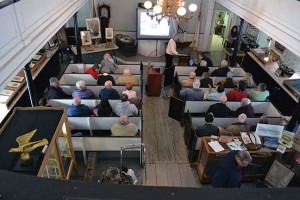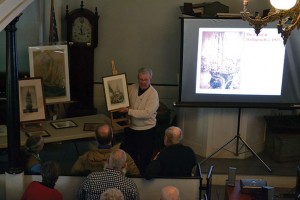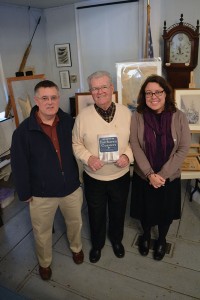“My dad was a great storyteller,” said Daniel Tucker who, when he was a boy, would sail with his father and brothers and listen to his dad retell the wild tales from the days when he was captain of the Coral, one of the last Fairhaven coasters – when Captain Claude S. Tucker would sail up and down the South Coast, hauling cargo to and fro, and encounter interesting characters along the way.
“He would tell these stories over and over,” said Dan, “and not one word would change.” Dan and his family preserved many of these tales by recording Captain Tucker as he recounted his schooner days in his own voice, and thus captured them forever. Captain Tucker’s remarkable life, however, was destined to be laid out in black and white and shared with the rest world in a new book titled The Last of the Fairhaven Coasters: Reliving the Era of the Coastal Schooner in Mattapoisett, written by Daniel Tucker, his sister-in-law Caroline Tucker, and Robert Demanche.
The trio highlighted some of the content from their book before a full house of over 50 people, who packed the inside of the Carriage House at the Mattapoisett Historical Museum on January 26 to hear some of the history of the Tucker family and how it tied into Mattapoisett.
Up until the early 1900s, schooners were the main vehicle for transporting cargo such as brick, building materials, fuel, cordwood, and even oysters before steam engines came along and made schooner transport obsolete.
In 1915, when Captain Tucker bought the Coral, schooners like her were ever-increasingly rare, nearing the end of the coastal schooner era. He was, in actuality, next to the last one to make a living in the coastal schooner business. The book tells of Captain Tucker’s extraordinary undertakings at the helm of the Coral, in addition to the well-documented and colorful history of the Tucker family who, for some time, would reside in Mattapoisett during the coastal schooner days.
Caroline Tucker married Captain Tucker’s third son, Tom, and became enthralled with the Tucker family history while on maternity leave with their first child twenty years ago, a time when access to the Internet exploded and fostered in her a new passion: genealogy.
The Tucker family was a farming family whose farmland traversed a large area of Rhode Island, including the present location of the University of Rhode Island, which actually began as an agricultural school. Over time, the land was repeatedly subdivided as generations passed land on to their offspring, with parcels of land dividing and shrinking until eventually, the small lots were no longer conducive to farming sustainable enough for a family to survive.
“They actually reproduced a lot,” said Caroline. After all, as she pointed out, the more children a farmer had, the more farm hands to work the land. She mentioned that there are still “hundreds of Tuckers over there.”
John Tucker had 15 children, of which Captain Claude S. Tucker was the eighth. Captain Tucker figured out early on that he hated farming, and for a brief time, he farmed bees. Until one day he traded an entire hive for a small wooden boat, which he would eventually trade in for a bigger boat, and so on.
“And Tuckers still do this,” said Caroline, making fun while emphasizing the importance of the nautical tradition to the Tucker family. Caroline, a librarian at the East Bridgewater High School, has a background in editing and publishing, so when the opportunity to combine her passion for history and her professional experience presented itself in the form of a book about Captain Tucker, she jumped aboard.
“So that got Captain Tucker in the boating business … until 70 years later when he finally gave it up,” said Caroline.
Dan recounted the time when Captain Tucker was given the task of delivering the materials for an entire house in one load for a contractor in Jamestown who wanted the cargo shipped right away, except Captain Tucker was all by himself with no crew to assist him with the large job. He did the job himself, and in three-below zero degree weather, to boot. He earned himself a reputation for a reliable, not to mention tough, schooner Captain.
Captain Tucker invited many an interesting character into his story, adding adventure and color to the book’s history. For example, there was one man referred to only as “Old Nick,” a mate named George Gale, a jack-of-all-trades with artistic talent, who created etchings of the Coral that Dan had with him at the lecture on Sunday. Even Dr. Suess, before he was famous, was a prominent character in Captain Tucker’s story. Dr. Suess was illustrating marketing materials for Esso when it was a subsidiary of the Standard Oil Company at the time the two men met.
The audience even heard the voice of Captain Tucker himself in a recording that retold a story of one of his triumphs during his career on the Coral. Photographs accompanied the lecture which brought the story to life.
Captain Tucker even had his own connection to the Wanderer, the whaling ship built in Mattapoisett and the last to leave New Bedford, when he transported the sails and the piece of the Wanderer’s mast after she was grounded on some rocks during a storm in 1924.
The Coral would continue to haul cargo throughout the South Coast area for years until it met its demise in 1938 when it became hurricane vs. the Coral, as Dan put it. The entire starboard side was damaged, landing the Coral at what is now the southern yard of the Fairhaven Shipyard.
“There wasn’t enough money to fix it,” said Dan. “It would never sail again.”
Captain Tucker would continue to work on boats and yachts as a skipper, and for one winter, as the caretaker of the Morgan after it was relocated to Mystic, Connecticut.
For years, the Coral would continue to deteriorate where it was docked at the current Linberg Marina dockyard on Middle Street in Fairhaven. The Tuckers owned a small cottage across from what is presently the Seaport Inn and, whenever Captain Tucker would walk up Middle Street, Dan said his father would turn his head away, unable to look at his beloved vessel as she floated there, decaying. It was his first love, after all, and he brought up a family on the Coral. The bones of the Coral are still there, buried beneath backfill and rock at the Linberg Marina.
Dan choked back tears as he described the tombstone at Riverside Cemetery in Fairhaven that stands in honor of his father, a portrait of the Coral etched into the stone. “He loved it so much,” said Dan emotionally.
The Last of the Fairhaven Coasters essentially became a family project.
“We spent months pulling together the notes that would eventually become the chapters of this book,” said Caroline. “All our families have an interesting story to tell … This family is lucky enough to have its story told.”
By Jean Perry


